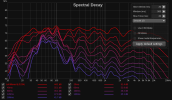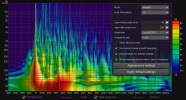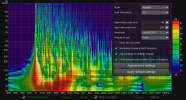AetherDrive
Member
- Joined
- Dec 6, 2022
- Messages
- 17
- Likes
- 13
Hi Everyone!
TLDR; what's your preferred FR Curve and EQ goals when using DSP?
I've built my own pair of speakers of my own design, you can find my write up of it here: Still Haven't Named Them. I stopped messing with them for a bit and am very happy with its sound signature except I found that it had a really bad peak in the 4k range, most music didn't highlight it but when it did it was audible. Long story short, tried Dirac Live to help fix it, which it did, but it completely changed the overall sound, removing some of the dynamic range in the bass and making everything more homogeneous in its presentation. Not an unenjoyable experience but it just feels like something is missing from the mix. I've AB'd tracks with and without the Dirac and have started to manually EQ them in an attempt to keep my preferred sound with some of the benefits from the Dirac's processing. What I've found is that my speakers have room for improvement but I'm not sure where to go beyond flattening out some of the dips and peaks that my FR chart shows. Also, I'm aware that EQ alone won't get me the same effect that Dirac gives, just trying to improve the base and then see where Dirac can take me, if I choose to use it.
I know it's a terribly subjective question and changes based on the speaker but are there any good FR Curve goals other than, make it flat, that you target/find that you prefer? I'm using a Dayton DSP-408 for active xo and eq.
TLDR; what's your preferred FR Curve and EQ goals when using DSP?
I've built my own pair of speakers of my own design, you can find my write up of it here: Still Haven't Named Them. I stopped messing with them for a bit and am very happy with its sound signature except I found that it had a really bad peak in the 4k range, most music didn't highlight it but when it did it was audible. Long story short, tried Dirac Live to help fix it, which it did, but it completely changed the overall sound, removing some of the dynamic range in the bass and making everything more homogeneous in its presentation. Not an unenjoyable experience but it just feels like something is missing from the mix. I've AB'd tracks with and without the Dirac and have started to manually EQ them in an attempt to keep my preferred sound with some of the benefits from the Dirac's processing. What I've found is that my speakers have room for improvement but I'm not sure where to go beyond flattening out some of the dips and peaks that my FR chart shows. Also, I'm aware that EQ alone won't get me the same effect that Dirac gives, just trying to improve the base and then see where Dirac can take me, if I choose to use it.
I know it's a terribly subjective question and changes based on the speaker but are there any good FR Curve goals other than, make it flat, that you target/find that you prefer? I'm using a Dayton DSP-408 for active xo and eq.
















